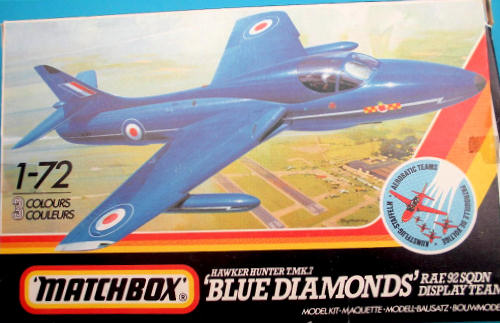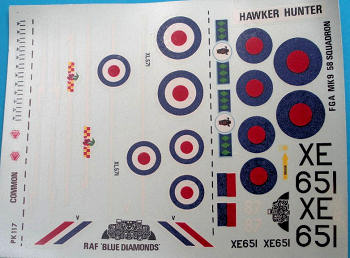
| KIT #: | PK-117 (1976) |
| PRICE: | $16.98 Out of producton |
| DECALS: | Two options |
| REVIEWER: | Victor Scheuerman |
| NOTES: | Includes bits to make single seat FGA.9 |

| HISTORY |
The Hawker Hunter prototype first flew on July 20, 1951, and entered RAF service in 1954. Hunters formed the backbone of RAF fighter strength up to the mid-1960s and over 400 were exported. Many Hunters remained in service in the UK and overseas well into the 1980s. The Hunter T7 two seater trainer entered RAF service in 1960. These were a combination of new aircraft and converted older F4 fighters. For the 1961/62 air display seasons, No 92 Squadron formed the RAF aerobatic team known as the ‘Blue Diamonds’. Though operating mainly the Hunter F6s, the team also had at least one T7 which often took part in the displays. The Hunter FGA 9 was an improved ground attack version of the F6, eventually serving with nine RAF squadrons with 92 being one of the last two. (Thanks to the kit instruction sheet.)
| THE KIT |
 The 56 parts (Included both single and two-seat canopies)
are cleanly molded no flash apparent. Surface detail is a combination of fine
raised lines (some on the wing control surfaces for some reason) and over done
engraved ones. As Matchbox generously
supplies both the single and two-seater in the same box, these are catered for
with two separate cockpit assemblies. Both have a ‘bench’ molding on the
interior for the seat(s) to attach to. The only difference is the trainer has
both seats molded to an aft bulkhead that completely closes off the aft
fuselage. The only additional details are the well sculptured aircrew and the
main instrument panels molded with the cockpit halves. With the cockpit being
painted black, and the fact that the decal sheet includes two very nice decals
for instrument panels, one should be able to get away with just adding some
harnesses to the seats.
The 56 parts (Included both single and two-seat canopies)
are cleanly molded no flash apparent. Surface detail is a combination of fine
raised lines (some on the wing control surfaces for some reason) and over done
engraved ones. As Matchbox generously
supplies both the single and two-seater in the same box, these are catered for
with two separate cockpit assemblies. Both have a ‘bench’ molding on the
interior for the seat(s) to attach to. The only difference is the trainer has
both seats molded to an aft bulkhead that completely closes off the aft
fuselage. The only additional details are the well sculptured aircrew and the
main instrument panels molded with the cockpit halves. With the cockpit being
painted black, and the fact that the decal sheet includes two very nice decals
for instrument panels, one should be able to get away with just adding some
harnesses to the seats.
These cockpits are treated a subassemblies that are glued
into the aft fuselage. In addition, two separate upper fuselage inserts are
provided to compensate for the difference in the variants of the configurations
at this join. The nose gear bay is framed in, but the main bays are not. All of
the tires have very nice details on the wheels, and the nose tire and leg are
one molding, though it does look good. All the gear doors are well molded with
perhaps being a little too thick, nothing that a few minutes of wet sanding on a
flat surface cannot improve.
Matchbox was not stingy with the external stores, offering
rocket pods and two sizes of drop tanks. The last external detail is the
separate lower fuselage brake that does have rib detail molded onto the interior
surface.
Assembly is covered over 14 steps that are well illustrated
and detail colour notes are offered at the end. This kit has a nice three view
of the single seater showing the camouflage pattern and decal placement and
t here is also a scrap view of the trainer’s lower nose showing a decal location.
The kit decals still look good and there are two options.
here is also a scrap view of the trainer’s lower nose showing a decal location.
The kit decals still look good and there are two options.
The aerobatic trainer used by 92 Squadron is over all blue
with white lightning bolts on the fuselage and drop tank. All the national
markings also have white piping and a miniature squadron motif is carried below
the cockpit on top of a checkered rectangle in the squadron colours (yellow and
red). The white wing tips are the final dash of colour and this would make a
most attractive subject.
An operational F.6 of 58 Squadron is the second option and
this is painted in the then standard Dark Green and Dark Grey over Light Grey
camouflage pattern. All of the national insignias are in the low-viz format but
the unit insignia is large and in full colour below the cockpit. This is an owl
on a white disc on top of a blue banner with green diamonds. In addition to
these markings, some basic stencils are included along with the previously
mentioned instrument panels.
| CONCLUSIONS |
The Revell Germany 1/72 single seat Hunter has been available for some time. As an after market resin conversion for the two seater will be available or is now, does remove some of the attraction of this kit. However, if you have one in the stash, by filling in the worst of the trenches, a decent kit can be made.
December 2008
If you would like your product reviewed fairly and quickly, please contact me or see other details in the Note to Contributors.